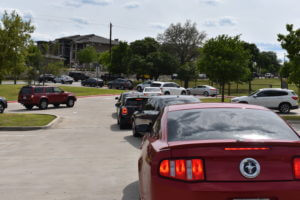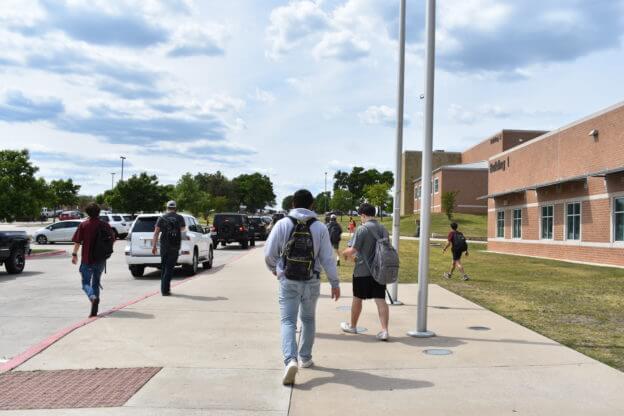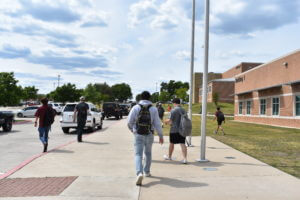
This is the view from the Vandegrift High School parking lot just after school let out April 27. Reporter Leslee Bassman began attempting to exit the lot at around 4 p.m., 15 minutes after school was dismissed, but did not reach RM 2222 until 4:32 p.m.
By LESLEE BASSMAN, Four Points News
Longtime Steiner Ranch resident Shannon Kramer said providing a secondary access road from the Vandegrift High and Four Points Middle school campuses is “nonnegotiable.”
“It’s a safety concern in general,” she said of the proposed road. “I can speak as a parent of an incoming (Vandegrift) freshman and my commute and my husband’s commute, having that road is essential for this community.”
However, a recent meeting between federal officials and school executives may offer hope to Kramer.
Understanding the basics
Located at 9500 McNeil Dr., Vandegrift adjoins the same tract as Four Points MS, at the heart of the Four Points community. The complex has only one exit—onto RM 2222, an often congested roadway.
Since 2013, Leander ISD staff and board of directors, together with local residents and the Four Points Traffic Committee, have been fighting to get a secondary access road through the property. However, the school complex is surrounded by the Balcones Canyonland Preserve, protected land requiring, quite literally, a federal act to enable the project to come to fruition.
Proponents of the road are seeking a permit from the U.S. Fish and Wildlife Service that will allow the school district to mitigate —pay funds so the agency can purchase other habitat for protected endangered species in place of a portion of the tract being taken for development, in this case a secondary access road.
The district has consistently maintained the proposed road, situated over a utility easement, would be used as an access for students and teachers, said Pam Waggoner, president of LISD’s Board of Trustees.
Productive meeting
Despite the lengthy process, the April 3 meeting — including not only members of the Austin USFWS office which the district has been working with but also the agency’s regional staff — was “productive,” Waggoner said.
Along with Waggoner, the meeting included the following key leaders confirmed SFWS public affairs specialist Lesli Gray: LISD Superintendent Dan Troxell; Jimmy Disler, LISD’s chief facilities and operations officer; Ted Koch, USFWS assistant regional director for ecological service; Adam Zerrenner, USFWS Austin field supervisor; and Tonya Sommer, USFWS branch chief, consultations and habitat conservation planning. Attorneys and biologists representing the stakeholders were present as well.
“I found it quite fascinating that we were able to clarify a few misconceptions that I believe the Albuquerque office was under,” Waggoner said of USFWS’ New Mexico office that supervises the agency’s Austin bureau. “So, we were able to tell our story and how long we had been dealing with this (road proposal).”
She said the Albuquerque staffers were unaware of how much time had transpired since the district started the process to obtain a permit to construct the road as well as “the fact that the local (USFWS) office had all of the information and that we have mitigated openly.”
“This seems like a miscommunication,” Waggoner said. “Remember, we have been supplying things for years and years and years. I’m sure they’ve gone from one hand to another as they reach Albuquerque or if they’ve even gotten to Albuquerque.”
Resolution in hand?
Waggoner said the parties seemed to have reached an agreement at the meeting that included the district contributing more mitigation land to be set aside in exchange for what USFWS has stated is the site’s endangered species habitat that will be taken by the proposed roadway.
“One of (USFWS’ Koch’s) first statements when he got there was ‘we are all looking for a way to get this done, to build the road,’” she said. “We have been a willing and open partner to everything they’ve needed us to do to protect the environment, to protect the integrity of the Balcones Canyonland Preserve. It is now in their court to move this process forward.”
Waggoner said the only barrier to progressing now is the district must amend its plan for the latest mitigation agreement.
“My understanding is the (LISD draft Habitat Conservation Plan) document will be resubmitted to us with whatever was agreed to or however Leander wants to move forward with that based on the discussion,” Gray said.
Once the document is submitted, USFWS will review it and will publish it “if it meets issuance criteria,” she said. The public comment period will come next, during which the agency will review the comments, respond to the comments and work with the applicant if any revisions need to be made, Gray said.
“Once we get to a place where we have an approved document, then we will issue the permit,” she said.
Leander ISD will complete its mitigation calculations and submit an application over the next several months, LISD Chief Communications Officer Corey Ryan said in an email.
“I remember saying, from the very beginning, this was a five-year project and it’s certainly showing to be,” Waggoner said. “There’s nothing left to be done, from the district’s standpoint, from the Four Points Traffic (Committee’s) standpoint. I just don’t know what else we have to meet about. There is just nothing left on the table that hasn’t been answered or we haven’t acquiesced to. It’s just time.”



